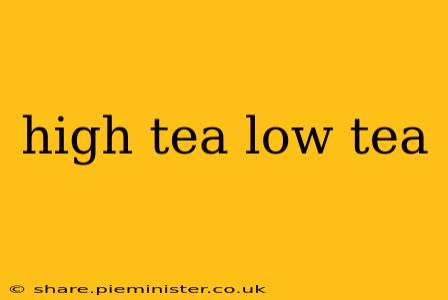Afternoon tea, a beloved British tradition, often leaves newcomers wondering about the difference between "high tea" and "low tea." The terms, while seemingly straightforward, are often confused, leading to misunderstandings about the formality and style of the event. This comprehensive guide will clarify the distinction, exploring the history, customs, and nuances of each.
What is High Tea?
Contrary to popular belief, "high tea" isn't a fancy, elaborate affair. In fact, it's quite the opposite. High tea is a simpler, more informal meal, typically served at around 5 or 6 pm. It evolved as a working-class meal, bridging the gap between the end of the workday and dinner. The "high" refers to the height of the table – a high table, or even a standing table, was used. Think of it as a hearty supper, rather than a delicate social occasion.
What does a typical high tea consist of? A high tea features a more substantial and savory menu. Expect to see things like:
- Sandwiches (often filled with hearty fillings like cheese and pickle or egg salad)
- Savory pastries and pies
- Heavily sugared cakes and pastries
- Bread and butter
- Tea (of course!)
What is Low Tea?
Low tea, in contrast, is the more formal and refined afternoon tea experience. It's a leisurely social gathering, typically served on low tables in the drawing-room between 3 and 5 pm. This tradition originated in the upper classes, emphasizing elegance and etiquette.
What makes low tea unique? Low tea is all about the presentation and atmosphere. Think delicate finger sandwiches, dainty pastries, scones with clotted cream and jam, and a wide selection of fine teas. The emphasis is on small portions and visual appeal.
What is the difference between afternoon tea and high tea?
This question often arises because the terms are frequently conflated. The key difference lies in the formality and the nature of the meal. Afternoon tea (often used synonymously with "low tea") is a more elegant social occasion, while high tea is a more substantial, informal meal. Afternoon tea focuses on a sophisticated array of sweet and savory treats, while high tea leans towards a heartier, more filling menu.
Is high tea served on a high table?
While the term "high tea" suggests a meal served at a high table, this isn't strictly true in modern practice. The term's origin is historical and refers to the working class's habit of eating a substantial meal at a high table or even standing, as opposed to the more refined low tables used for low tea.
What time is high tea served?
High tea is typically served between 5 and 6 pm, after a day of work, bridging the gap between the end of the workday and dinner. It’s a more practical meal, designed to fill the hunger gap, rather than a ceremonial event.
What time is low tea served?
Low tea, the more formal afternoon tea, usually takes place between 3 and 5 pm. It's a time for socializing and enjoying delicate treats in a relaxed yet elegant setting.
Conclusion
Understanding the difference between high tea and low tea requires looking beyond the literal meaning of the names and considering their historical contexts. Both offer unique experiences, representing different facets of British tea culture, reflecting social class and the changing patterns of daily life. Whether you opt for the hearty fare of high tea or the elegance of low tea, the enjoyment of a good cup of tea with delightful treats remains the heart of this timeless tradition.
